Comparative Study: Tuberculosis Prevalence in India and Australia
VerifiedAdded on 2022/12/27
|7
|1736
|97
Report
AI Summary
This report provides a comparative analysis of tuberculosis (TB) in India and Australia. It begins by defining TB, incidence, and prevalence rates. The report highlights that TB is significantly more prevalent in India than in Australia, with India bearing a substantial global burden. Factors contributing to this disparity include poverty, overcrowded living conditions, and co-morbidities like HIV and malnutrition in India. Australia, on the other hand, benefits from better living standards, effective TB control programs, and increased awareness. The report cites data from various sources, including the Department of Health and WHO, to support its claims. It concludes that while Australia is on track to eliminate TB by 2050, India faces ongoing challenges due to complex social determinants and less effective government interventions when compared to Australia. The report emphasizes the need for improved public health strategies in India to combat the disease effectively.
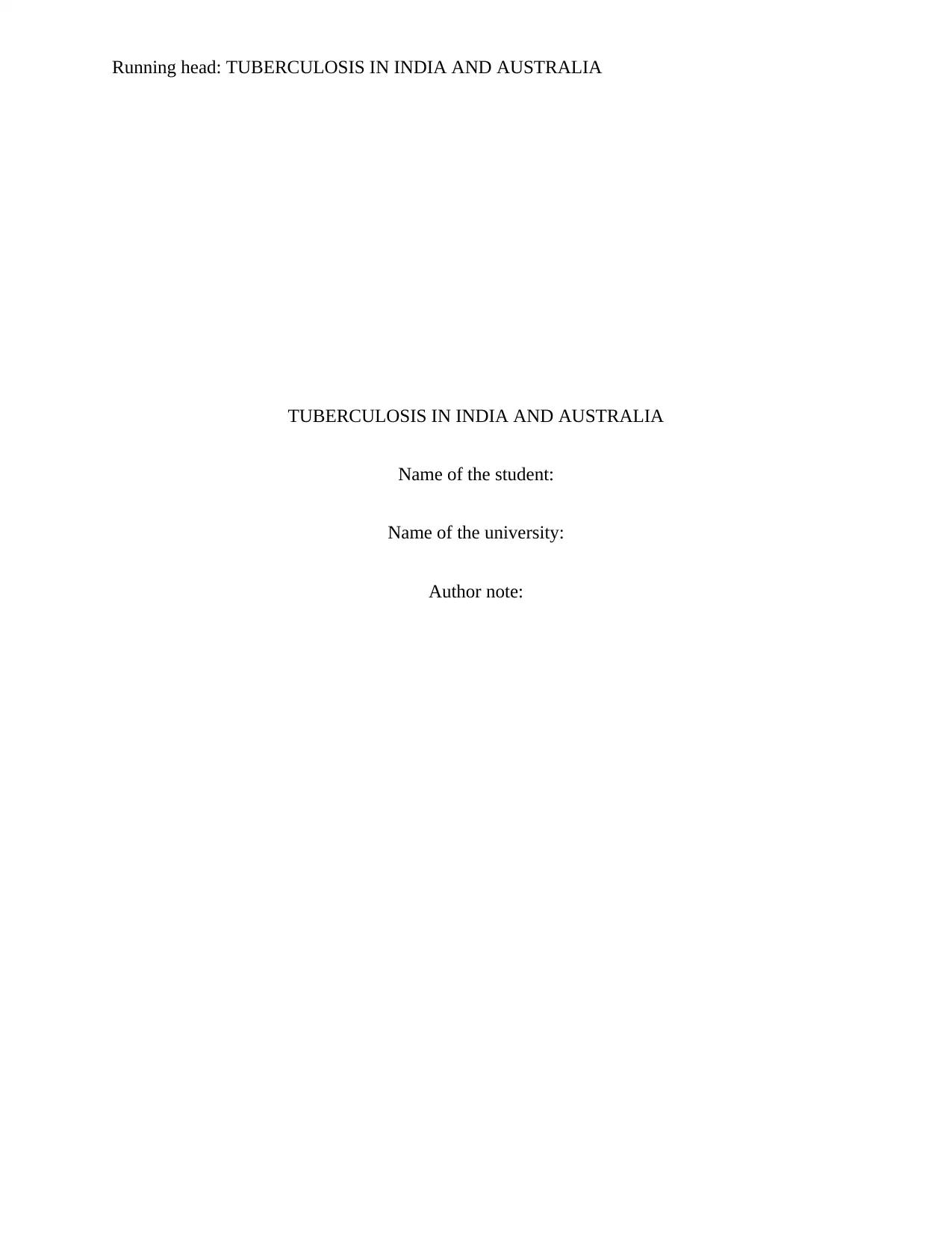
Running head: TUBERCULOSIS IN INDIA AND AUSTRALIA
TUBERCULOSIS IN INDIA AND AUSTRALIA
Name of the student:
Name of the university:
Author note:
TUBERCULOSIS IN INDIA AND AUSTRALIA
Name of the student:
Name of the university:
Author note:
Paraphrase This Document
Need a fresh take? Get an instant paraphrase of this document with our AI Paraphraser
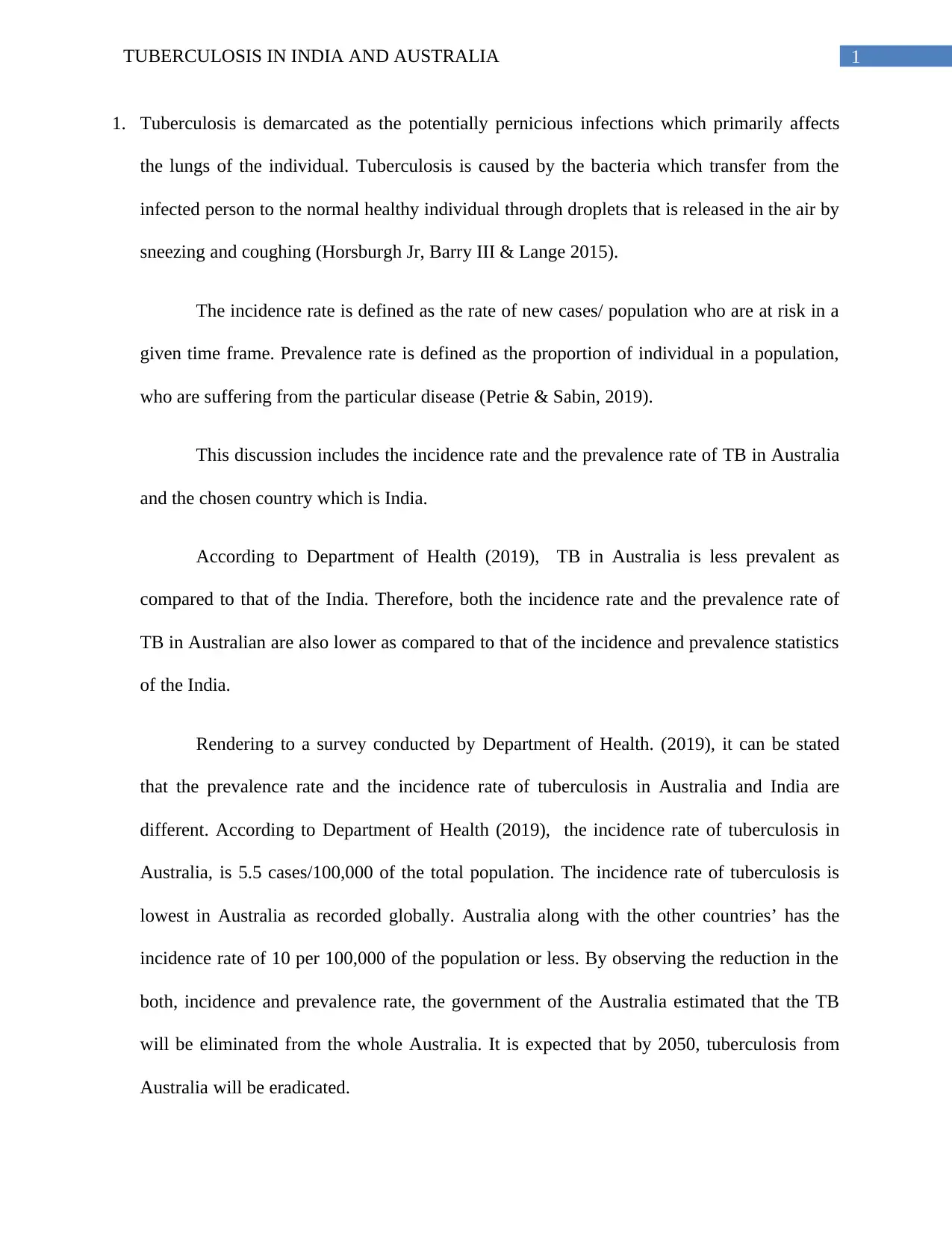
1TUBERCULOSIS IN INDIA AND AUSTRALIA
1. Tuberculosis is demarcated as the potentially pernicious infections which primarily affects
the lungs of the individual. Tuberculosis is caused by the bacteria which transfer from the
infected person to the normal healthy individual through droplets that is released in the air by
sneezing and coughing (Horsburgh Jr, Barry III & Lange 2015).
The incidence rate is defined as the rate of new cases/ population who are at risk in a
given time frame. Prevalence rate is defined as the proportion of individual in a population,
who are suffering from the particular disease (Petrie & Sabin, 2019).
This discussion includes the incidence rate and the prevalence rate of TB in Australia
and the chosen country which is India.
According to Department of Health (2019), TB in Australia is less prevalent as
compared to that of the India. Therefore, both the incidence rate and the prevalence rate of
TB in Australian are also lower as compared to that of the incidence and prevalence statistics
of the India.
Rendering to a survey conducted by Department of Health. (2019), it can be stated
that the prevalence rate and the incidence rate of tuberculosis in Australia and India are
different. According to Department of Health (2019), the incidence rate of tuberculosis in
Australia, is 5.5 cases/100,000 of the total population. The incidence rate of tuberculosis is
lowest in Australia as recorded globally. Australia along with the other countries’ has the
incidence rate of 10 per 100,000 of the population or less. By observing the reduction in the
both, incidence and prevalence rate, the government of the Australia estimated that the TB
will be eliminated from the whole Australia. It is expected that by 2050, tuberculosis from
Australia will be eradicated.
1. Tuberculosis is demarcated as the potentially pernicious infections which primarily affects
the lungs of the individual. Tuberculosis is caused by the bacteria which transfer from the
infected person to the normal healthy individual through droplets that is released in the air by
sneezing and coughing (Horsburgh Jr, Barry III & Lange 2015).
The incidence rate is defined as the rate of new cases/ population who are at risk in a
given time frame. Prevalence rate is defined as the proportion of individual in a population,
who are suffering from the particular disease (Petrie & Sabin, 2019).
This discussion includes the incidence rate and the prevalence rate of TB in Australia
and the chosen country which is India.
According to Department of Health (2019), TB in Australia is less prevalent as
compared to that of the India. Therefore, both the incidence rate and the prevalence rate of
TB in Australian are also lower as compared to that of the incidence and prevalence statistics
of the India.
Rendering to a survey conducted by Department of Health. (2019), it can be stated
that the prevalence rate and the incidence rate of tuberculosis in Australia and India are
different. According to Department of Health (2019), the incidence rate of tuberculosis in
Australia, is 5.5 cases/100,000 of the total population. The incidence rate of tuberculosis is
lowest in Australia as recorded globally. Australia along with the other countries’ has the
incidence rate of 10 per 100,000 of the population or less. By observing the reduction in the
both, incidence and prevalence rate, the government of the Australia estimated that the TB
will be eliminated from the whole Australia. It is expected that by 2050, tuberculosis from
Australia will be eradicated.
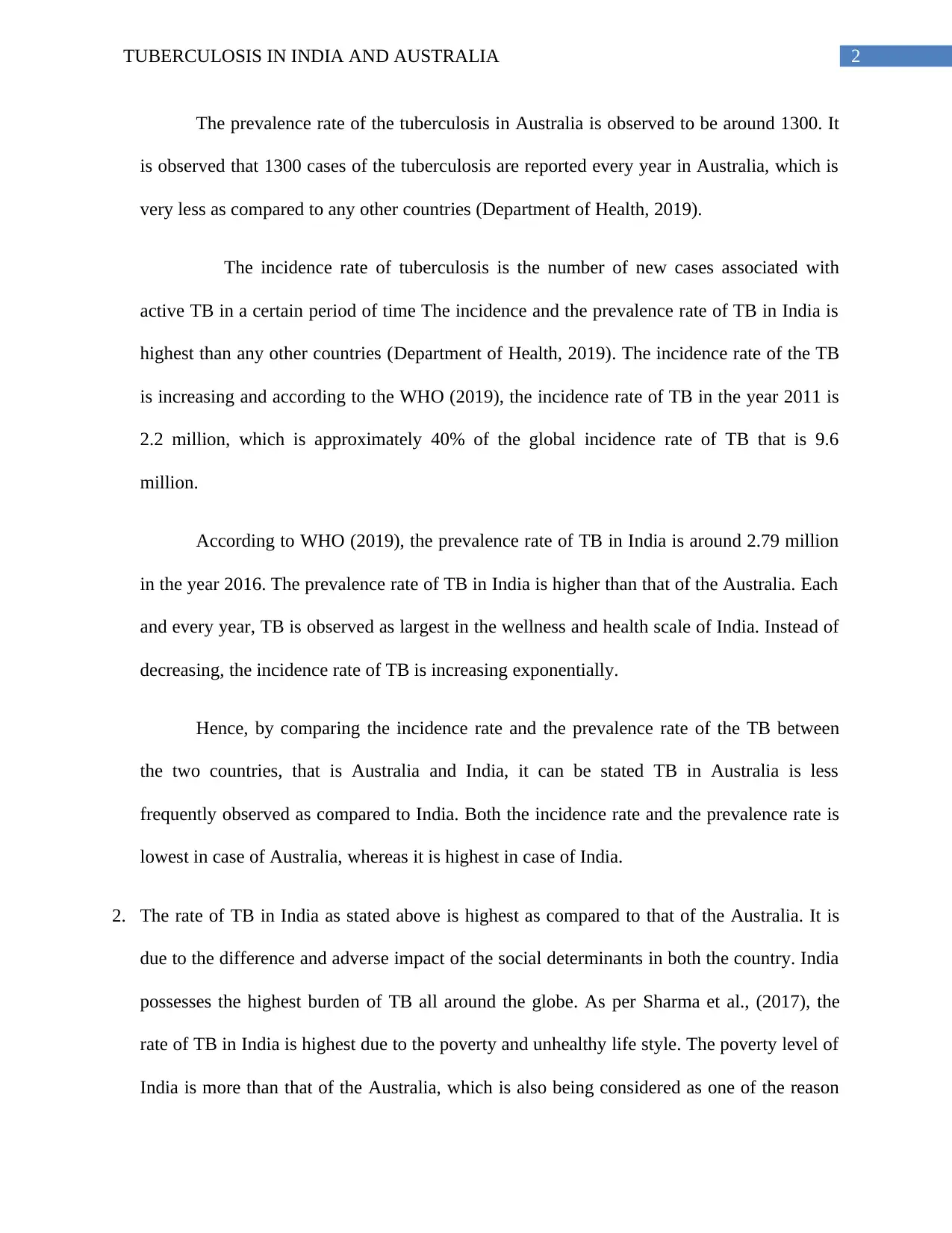
2TUBERCULOSIS IN INDIA AND AUSTRALIA
The prevalence rate of the tuberculosis in Australia is observed to be around 1300. It
is observed that 1300 cases of the tuberculosis are reported every year in Australia, which is
very less as compared to any other countries (Department of Health, 2019).
The incidence rate of tuberculosis is the number of new cases associated with
active TB in a certain period of time The incidence and the prevalence rate of TB in India is
highest than any other countries (Department of Health, 2019). The incidence rate of the TB
is increasing and according to the WHO (2019), the incidence rate of TB in the year 2011 is
2.2 million, which is approximately 40% of the global incidence rate of TB that is 9.6
million.
According to WHO (2019), the prevalence rate of TB in India is around 2.79 million
in the year 2016. The prevalence rate of TB in India is higher than that of the Australia. Each
and every year, TB is observed as largest in the wellness and health scale of India. Instead of
decreasing, the incidence rate of TB is increasing exponentially.
Hence, by comparing the incidence rate and the prevalence rate of the TB between
the two countries, that is Australia and India, it can be stated TB in Australia is less
frequently observed as compared to India. Both the incidence rate and the prevalence rate is
lowest in case of Australia, whereas it is highest in case of India.
2. The rate of TB in India as stated above is highest as compared to that of the Australia. It is
due to the difference and adverse impact of the social determinants in both the country. India
possesses the highest burden of TB all around the globe. As per Sharma et al., (2017), the
rate of TB in India is highest due to the poverty and unhealthy life style. The poverty level of
India is more than that of the Australia, which is also being considered as one of the reason
The prevalence rate of the tuberculosis in Australia is observed to be around 1300. It
is observed that 1300 cases of the tuberculosis are reported every year in Australia, which is
very less as compared to any other countries (Department of Health, 2019).
The incidence rate of tuberculosis is the number of new cases associated with
active TB in a certain period of time The incidence and the prevalence rate of TB in India is
highest than any other countries (Department of Health, 2019). The incidence rate of the TB
is increasing and according to the WHO (2019), the incidence rate of TB in the year 2011 is
2.2 million, which is approximately 40% of the global incidence rate of TB that is 9.6
million.
According to WHO (2019), the prevalence rate of TB in India is around 2.79 million
in the year 2016. The prevalence rate of TB in India is higher than that of the Australia. Each
and every year, TB is observed as largest in the wellness and health scale of India. Instead of
decreasing, the incidence rate of TB is increasing exponentially.
Hence, by comparing the incidence rate and the prevalence rate of the TB between
the two countries, that is Australia and India, it can be stated TB in Australia is less
frequently observed as compared to India. Both the incidence rate and the prevalence rate is
lowest in case of Australia, whereas it is highest in case of India.
2. The rate of TB in India as stated above is highest as compared to that of the Australia. It is
due to the difference and adverse impact of the social determinants in both the country. India
possesses the highest burden of TB all around the globe. As per Sharma et al., (2017), the
rate of TB in India is highest due to the poverty and unhealthy life style. The poverty level of
India is more than that of the Australia, which is also being considered as one of the reason
⊘ This is a preview!⊘
Do you want full access?
Subscribe today to unlock all pages.

Trusted by 1+ million students worldwide
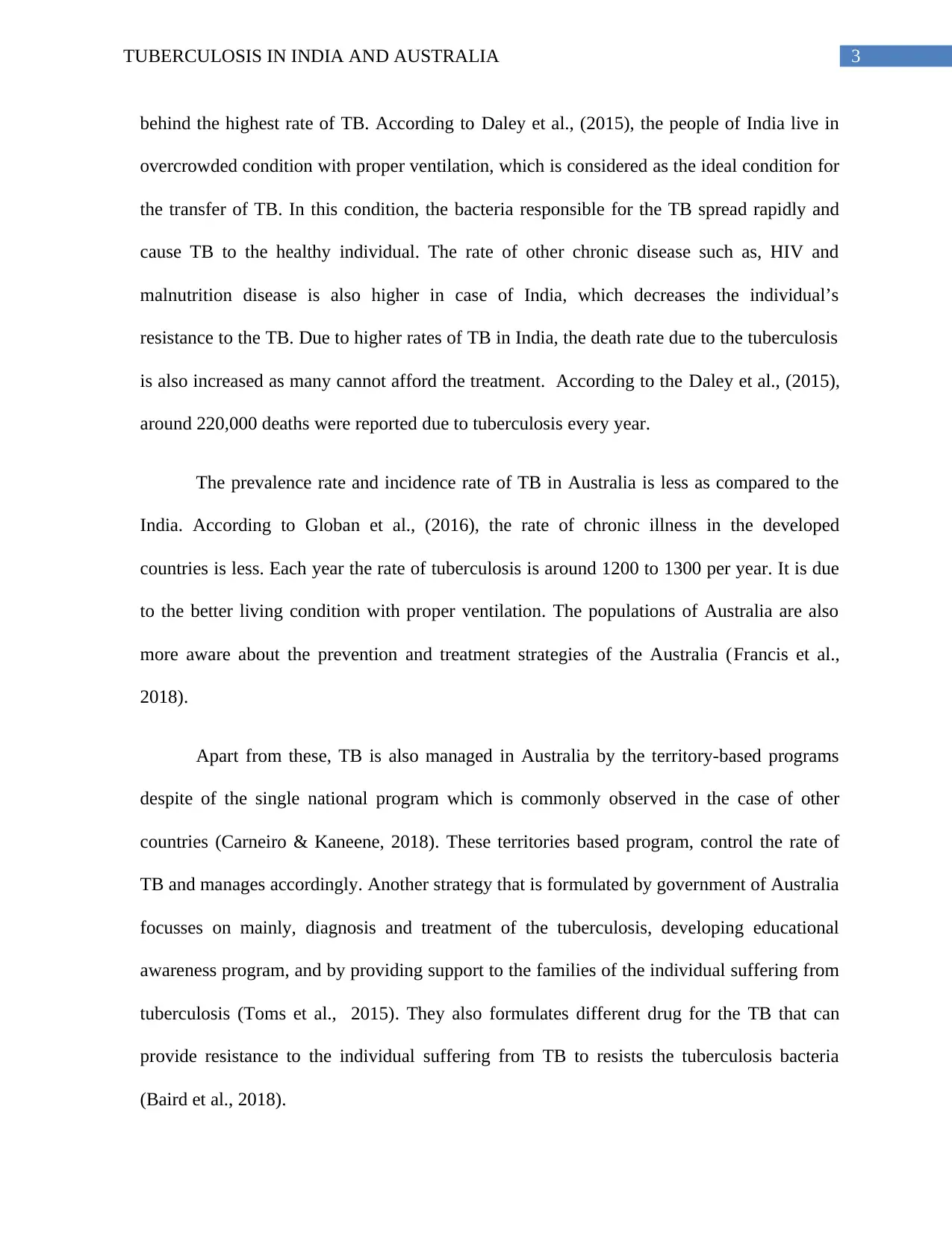
3TUBERCULOSIS IN INDIA AND AUSTRALIA
behind the highest rate of TB. According to Daley et al., (2015), the people of India live in
overcrowded condition with proper ventilation, which is considered as the ideal condition for
the transfer of TB. In this condition, the bacteria responsible for the TB spread rapidly and
cause TB to the healthy individual. The rate of other chronic disease such as, HIV and
malnutrition disease is also higher in case of India, which decreases the individual’s
resistance to the TB. Due to higher rates of TB in India, the death rate due to the tuberculosis
is also increased as many cannot afford the treatment. According to the Daley et al., (2015),
around 220,000 deaths were reported due to tuberculosis every year.
The prevalence rate and incidence rate of TB in Australia is less as compared to the
India. According to Globan et al., (2016), the rate of chronic illness in the developed
countries is less. Each year the rate of tuberculosis is around 1200 to 1300 per year. It is due
to the better living condition with proper ventilation. The populations of Australia are also
more aware about the prevention and treatment strategies of the Australia (Francis et al.,
2018).
Apart from these, TB is also managed in Australia by the territory-based programs
despite of the single national program which is commonly observed in the case of other
countries (Carneiro & Kaneene, 2018). These territories based program, control the rate of
TB and manages accordingly. Another strategy that is formulated by government of Australia
focusses on mainly, diagnosis and treatment of the tuberculosis, developing educational
awareness program, and by providing support to the families of the individual suffering from
tuberculosis (Toms et al., 2015). They also formulates different drug for the TB that can
provide resistance to the individual suffering from TB to resists the tuberculosis bacteria
(Baird et al., 2018).
behind the highest rate of TB. According to Daley et al., (2015), the people of India live in
overcrowded condition with proper ventilation, which is considered as the ideal condition for
the transfer of TB. In this condition, the bacteria responsible for the TB spread rapidly and
cause TB to the healthy individual. The rate of other chronic disease such as, HIV and
malnutrition disease is also higher in case of India, which decreases the individual’s
resistance to the TB. Due to higher rates of TB in India, the death rate due to the tuberculosis
is also increased as many cannot afford the treatment. According to the Daley et al., (2015),
around 220,000 deaths were reported due to tuberculosis every year.
The prevalence rate and incidence rate of TB in Australia is less as compared to the
India. According to Globan et al., (2016), the rate of chronic illness in the developed
countries is less. Each year the rate of tuberculosis is around 1200 to 1300 per year. It is due
to the better living condition with proper ventilation. The populations of Australia are also
more aware about the prevention and treatment strategies of the Australia (Francis et al.,
2018).
Apart from these, TB is also managed in Australia by the territory-based programs
despite of the single national program which is commonly observed in the case of other
countries (Carneiro & Kaneene, 2018). These territories based program, control the rate of
TB and manages accordingly. Another strategy that is formulated by government of Australia
focusses on mainly, diagnosis and treatment of the tuberculosis, developing educational
awareness program, and by providing support to the families of the individual suffering from
tuberculosis (Toms et al., 2015). They also formulates different drug for the TB that can
provide resistance to the individual suffering from TB to resists the tuberculosis bacteria
(Baird et al., 2018).
Paraphrase This Document
Need a fresh take? Get an instant paraphrase of this document with our AI Paraphraser
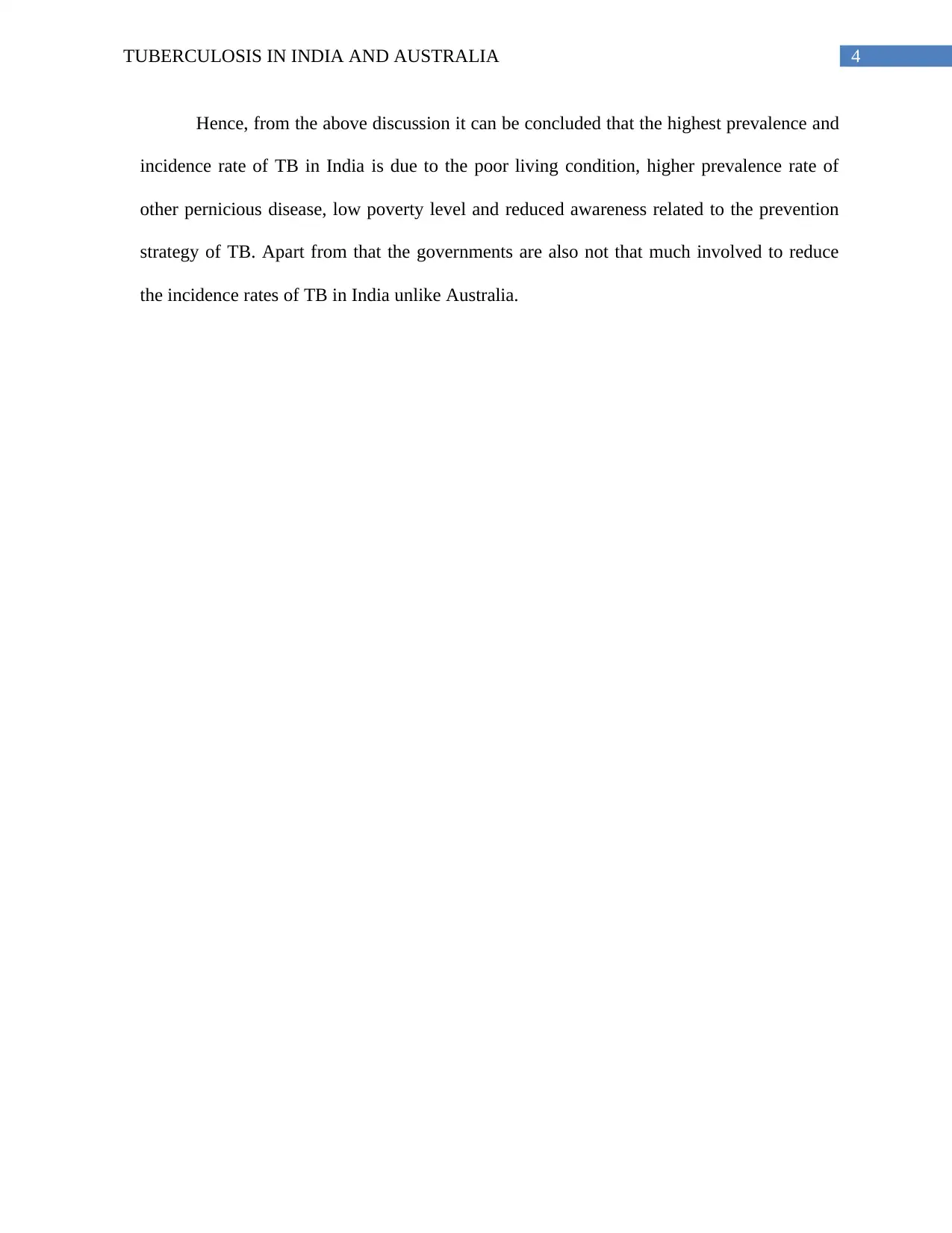
4TUBERCULOSIS IN INDIA AND AUSTRALIA
Hence, from the above discussion it can be concluded that the highest prevalence and
incidence rate of TB in India is due to the poor living condition, higher prevalence rate of
other pernicious disease, low poverty level and reduced awareness related to the prevention
strategy of TB. Apart from that the governments are also not that much involved to reduce
the incidence rates of TB in India unlike Australia.
Hence, from the above discussion it can be concluded that the highest prevalence and
incidence rate of TB in India is due to the poor living condition, higher prevalence rate of
other pernicious disease, low poverty level and reduced awareness related to the prevention
strategy of TB. Apart from that the governments are also not that much involved to reduce
the incidence rates of TB in India unlike Australia.
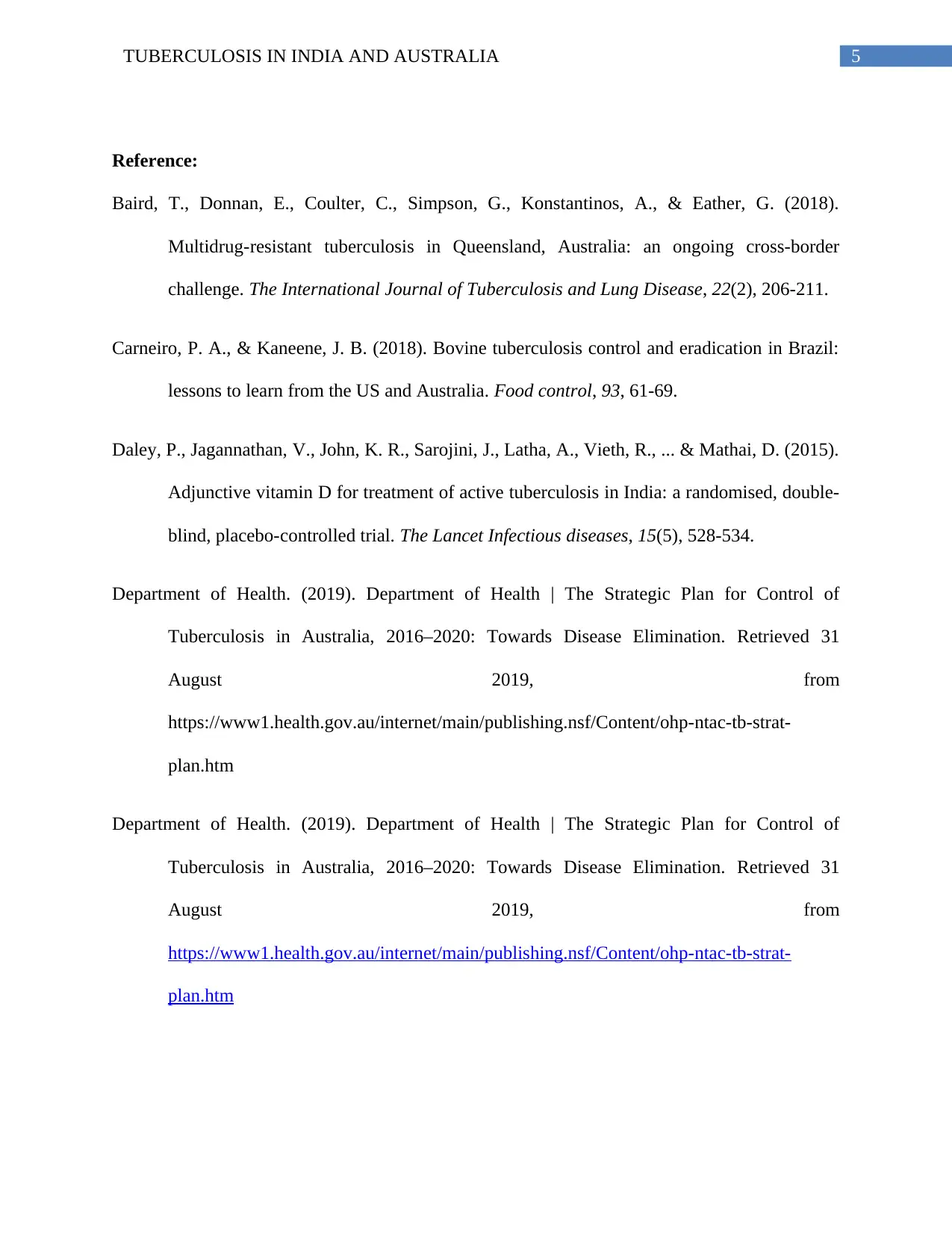
5TUBERCULOSIS IN INDIA AND AUSTRALIA
Reference:
Baird, T., Donnan, E., Coulter, C., Simpson, G., Konstantinos, A., & Eather, G. (2018).
Multidrug-resistant tuberculosis in Queensland, Australia: an ongoing cross-border
challenge. The International Journal of Tuberculosis and Lung Disease, 22(2), 206-211.
Carneiro, P. A., & Kaneene, J. B. (2018). Bovine tuberculosis control and eradication in Brazil:
lessons to learn from the US and Australia. Food control, 93, 61-69.
Daley, P., Jagannathan, V., John, K. R., Sarojini, J., Latha, A., Vieth, R., ... & Mathai, D. (2015).
Adjunctive vitamin D for treatment of active tuberculosis in India: a randomised, double-
blind, placebo-controlled trial. The Lancet Infectious diseases, 15(5), 528-534.
Department of Health. (2019). Department of Health | The Strategic Plan for Control of
Tuberculosis in Australia, 2016–2020: Towards Disease Elimination. Retrieved 31
August 2019, from
https://www1.health.gov.au/internet/main/publishing.nsf/Content/ohp-ntac-tb-strat-
plan.htm
Department of Health. (2019). Department of Health | The Strategic Plan for Control of
Tuberculosis in Australia, 2016–2020: Towards Disease Elimination. Retrieved 31
August 2019, from
https://www1.health.gov.au/internet/main/publishing.nsf/Content/ohp-ntac-tb-strat-
plan.htm
Reference:
Baird, T., Donnan, E., Coulter, C., Simpson, G., Konstantinos, A., & Eather, G. (2018).
Multidrug-resistant tuberculosis in Queensland, Australia: an ongoing cross-border
challenge. The International Journal of Tuberculosis and Lung Disease, 22(2), 206-211.
Carneiro, P. A., & Kaneene, J. B. (2018). Bovine tuberculosis control and eradication in Brazil:
lessons to learn from the US and Australia. Food control, 93, 61-69.
Daley, P., Jagannathan, V., John, K. R., Sarojini, J., Latha, A., Vieth, R., ... & Mathai, D. (2015).
Adjunctive vitamin D for treatment of active tuberculosis in India: a randomised, double-
blind, placebo-controlled trial. The Lancet Infectious diseases, 15(5), 528-534.
Department of Health. (2019). Department of Health | The Strategic Plan for Control of
Tuberculosis in Australia, 2016–2020: Towards Disease Elimination. Retrieved 31
August 2019, from
https://www1.health.gov.au/internet/main/publishing.nsf/Content/ohp-ntac-tb-strat-
plan.htm
Department of Health. (2019). Department of Health | The Strategic Plan for Control of
Tuberculosis in Australia, 2016–2020: Towards Disease Elimination. Retrieved 31
August 2019, from
https://www1.health.gov.au/internet/main/publishing.nsf/Content/ohp-ntac-tb-strat-
plan.htm
⊘ This is a preview!⊘
Do you want full access?
Subscribe today to unlock all pages.

Trusted by 1+ million students worldwide
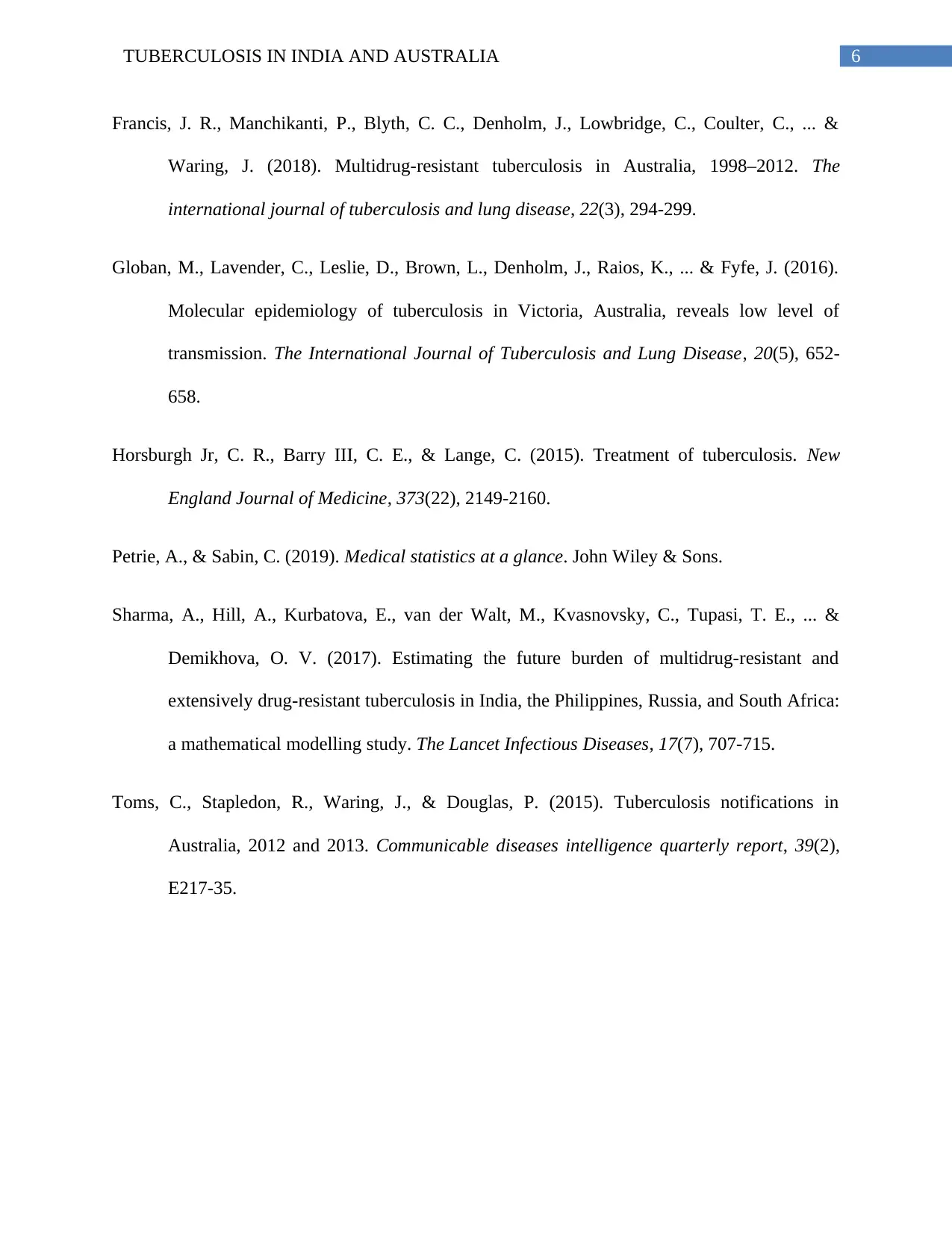
6TUBERCULOSIS IN INDIA AND AUSTRALIA
Francis, J. R., Manchikanti, P., Blyth, C. C., Denholm, J., Lowbridge, C., Coulter, C., ... &
Waring, J. (2018). Multidrug-resistant tuberculosis in Australia, 1998–2012. The
international journal of tuberculosis and lung disease, 22(3), 294-299.
Globan, M., Lavender, C., Leslie, D., Brown, L., Denholm, J., Raios, K., ... & Fyfe, J. (2016).
Molecular epidemiology of tuberculosis in Victoria, Australia, reveals low level of
transmission. The International Journal of Tuberculosis and Lung Disease, 20(5), 652-
658.
Horsburgh Jr, C. R., Barry III, C. E., & Lange, C. (2015). Treatment of tuberculosis. New
England Journal of Medicine, 373(22), 2149-2160.
Petrie, A., & Sabin, C. (2019). Medical statistics at a glance. John Wiley & Sons.
Sharma, A., Hill, A., Kurbatova, E., van der Walt, M., Kvasnovsky, C., Tupasi, T. E., ... &
Demikhova, O. V. (2017). Estimating the future burden of multidrug-resistant and
extensively drug-resistant tuberculosis in India, the Philippines, Russia, and South Africa:
a mathematical modelling study. The Lancet Infectious Diseases, 17(7), 707-715.
Toms, C., Stapledon, R., Waring, J., & Douglas, P. (2015). Tuberculosis notifications in
Australia, 2012 and 2013. Communicable diseases intelligence quarterly report, 39(2),
E217-35.
Francis, J. R., Manchikanti, P., Blyth, C. C., Denholm, J., Lowbridge, C., Coulter, C., ... &
Waring, J. (2018). Multidrug-resistant tuberculosis in Australia, 1998–2012. The
international journal of tuberculosis and lung disease, 22(3), 294-299.
Globan, M., Lavender, C., Leslie, D., Brown, L., Denholm, J., Raios, K., ... & Fyfe, J. (2016).
Molecular epidemiology of tuberculosis in Victoria, Australia, reveals low level of
transmission. The International Journal of Tuberculosis and Lung Disease, 20(5), 652-
658.
Horsburgh Jr, C. R., Barry III, C. E., & Lange, C. (2015). Treatment of tuberculosis. New
England Journal of Medicine, 373(22), 2149-2160.
Petrie, A., & Sabin, C. (2019). Medical statistics at a glance. John Wiley & Sons.
Sharma, A., Hill, A., Kurbatova, E., van der Walt, M., Kvasnovsky, C., Tupasi, T. E., ... &
Demikhova, O. V. (2017). Estimating the future burden of multidrug-resistant and
extensively drug-resistant tuberculosis in India, the Philippines, Russia, and South Africa:
a mathematical modelling study. The Lancet Infectious Diseases, 17(7), 707-715.
Toms, C., Stapledon, R., Waring, J., & Douglas, P. (2015). Tuberculosis notifications in
Australia, 2012 and 2013. Communicable diseases intelligence quarterly report, 39(2),
E217-35.
1 out of 7
Related Documents
Your All-in-One AI-Powered Toolkit for Academic Success.
+13062052269
info@desklib.com
Available 24*7 on WhatsApp / Email
![[object Object]](/_next/static/media/star-bottom.7253800d.svg)
Unlock your academic potential
Copyright © 2020–2025 A2Z Services. All Rights Reserved. Developed and managed by ZUCOL.




